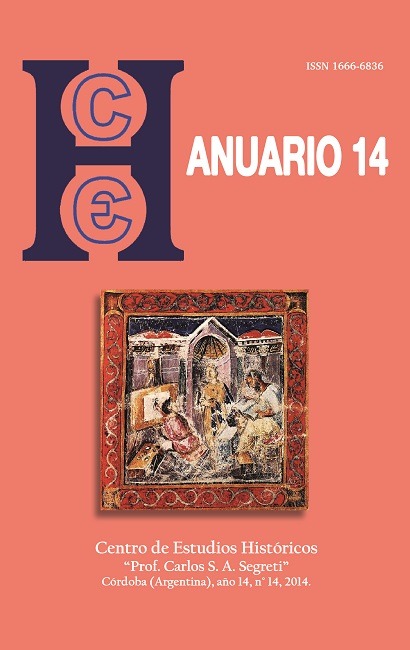Reminiscences of death and the spreading of pain in the funerary stele of Lucius Trebius Divus
DOI:
https://doi.org/10.52885/2683-9164.v0.n14.22141Keywords:
death, memory, pain and epigraphyAbstract
Recent studies have shown a continuous increase of analyses of the ways in which people die, treatment of the bodies, types of graves, deposit location at the burial site, artifacts, identity constructions in sarcophagi and reliefs, aside from the funerary landscape. Taking into consideration the relevance of mortuary representations in the Roman Mediterranean, we will analyze, in historic terms, the social experience of death, as it encompasses the way in which the dead in the society came to be remembered or, depending on the circumstances, condemned to oblivion. Relating to the topic, the document repertory contemplates the tombstone of Lucius Trebius Diuus. Therefore, we will focus on the most particular and emotional dimensions of remembrance of the dead, as the grave could become a place for pilgrimage and reverence, a house or sanctuary for the dead, and the associations of the dead with the deities and their attributes, that not only kept his name alive, but met the emotional needs of survivors. From there, we will trace reflections on public expressions of pain and the insertion of more particular and emotional dimensions in the ways in which the dead were remembered in Roman society.
Downloads
References
APPADURAI Arjun,, “Introduction: commodities and the politics of value”, APPADURAI Arjun (comp.), The social life of things, Cambridge, Cambridge University Press, 1986.
ARCE Javier, “Funus Imperatorum: Los Funerales de los Emperadores Romanos”, Madrid, Alianza, 1990.
BERSANI Silvia G., «Epigrafia e storia di Roma », Roma, Carocci, 2014. 41 BIRK, 2011.
BIRK Stine, “Man or woman. Cross-gendering and individuality on third century Roman sarcophagi”, ELSNER Jás y HUSKINSON Janet, (comp.), “Life, death and representation. Some new work on Roman sarcophagi”, New YorkBerlin, Walter de Gruyter Gmbh & Co. KG, 2011.
CICERO M. T., De senectute. Books I-II. Trad. Domenico Lassandro e Giuseppe Micunco. Italian: UTET, 2007.
DIXON S., “Conflict in the Roman family”, RAWSON B. y WEAVER Paul (comp.), “The Roman family in Italy. Status, sentiment, Space”, Oxford, Oxford University Press, 1999.
ECKARDT Hella y WILLIAMS Howard, “Objects without a past? The use of Roman objects in early Anglo-Saxon graves”, WILLIANS Howard, “Archaeologies of remembrance”, New York: KaPP, 2003.
ELIAS Norbert, A solidão dos moribundos. Seguido de envelhecer e morrer. Rio de Janeiro: Zahar, 2001.
FISHWICK Duncan, “The Deification of Claudius”, The Classical Quarterly, Vol. 52, No. 1, 2002.
FUNARI Pedro Paulo A., “A diversidade de concepções sobre a morte e a magia: uma abordagem antropológica”, BUSTAMANTE R. C., R. C. (comp.), “Vida, morte e magia no mundo antigo”, Rio de Janeiro, NEAUERJ, 2008.
GOWING Alain M., “Empire and memory: the representation of the Roman Republic in imperial culture”, Cambridge, Cambridge University Press, 2005.
GRAHAN Emma-Jayne, “Memory and materiality: re-embodying the roman funeral”, HOPE Valerie, y HUSKINSON Janet, Memory and mourning. Studies on roman death, Oxford: OXBOW BOOKS, 2011.
HOPE Valerie, “Contempt and respect. The treatment of the corpse in Ancient Rome”, HOPE Valerie, y MARSHALL Eiream, (comp.), “Death and disease in the Ancient city”, London and New York, Routledge, 2000.
HOPE Valerie,“Remembering to mourn personal mementos of the dead in Ancient Rome”, Valerie HOPE y Janet HUSKINSON, Janet (comp.), Memory and Mourning: Studies on Roman Death,Oxford, Oxbow Books, 2011.
HOPE Valerie, “Remembering Rome. Memory, funerary monuments and the Roman soldier”, WILLIAMS H., “Archaeologies of remembrance. Death and memory in past societies”, New York: Kluwer Academic, 2003.
HULLS Jean-Michel, “Monuments: grief and Consolation in Statius Silvae 33”, HOPE Valerie M. y HUSKINSON Janet , “Memory and mourning. Studies on Roman death”, Oxford, Oxbow Books, 2011.
HUSKINSON Janet, “Constructing childhood on roman funerary memorials”, “Hesperia Supplements”, vol. 41, Italy, 2007.
HUSKINSON Janet, “Looking for culture, identity and power”, HUSKINSON Janet, “Experiencing Rome. Culture, identity and power in the Roman empire”, Canada, Routledge, 2005.
JONES S., “The archaeology of ethnicity: constructing identities in the past and present”, London, Routledge, 1997.
KREITZER Larry, “Apotheosis of the Roman Emperor”, The Biblical Archaeologist, Vol. 53, No. 4, Dec., 1990.
Mendoza LUJÁN Erik, “Espántame, panteón. Los espacios y usos del cuerpomuerto”, Vita Brevis, Año 1, núm. 1, Enero-Junio, 2012.
METCALF Peter, y HUNTINGTON Richard, Celebrations death. The anthropology of mortuary ritual. Cambridge: Cambridge University Press, 2010.
MORIN Edgar, El ser humano y a muerte. Barcelona: Kairós, 2003.
PRICE Simon, “From noble funerals to divine cult: the Consacration of Roman Emperors”, CANNADINE David y PRICE Simon, Simon (comp.), “Rituals of Royalty: Power and Ceremonial in Traditional Societies”, Cambridge, University Press, 1992.
RUSSEL Ben, “The Roman sarcophagus “industry’: a reconsideration”, ELSNER Jás y HUSKINSON Janet (comp.), “Life, death and representation. Some new work on Roman sarcophagi”, New YorkBerlin, Walter de Gruyter Gmbh & Co. KG, 2011.
SALLER Richard P., “Patriarchy, property and death in the Roman family”. Cambridge, Cambridge Studies in Population, Economy and Society in Past Time, 1994.
SARTORI A., Guida alla sezione epigrafica delle raccolte archeologiche di Milano. Milano: Comuni di Milano, 1994.
SCHEID Jonh, Rito e religione dei romani, Bergamo, Sestante Edizioni, 2009.
SMITH C. J., “The Roman Clan. The gens from Ancient ideology to Modern Anthropology”, Cambridge, Cambridge University Press, 2006.
THOMAS Edmund, “Houses of the dead. Columnar sarcophagi as micro-architecture”, ELSNER Jás y HUSKINSON Janet (comp.), “Life, death and representation. Some new work on Roman sarcophagi”, New YorkBerlin, Walter de Gruyter Gmbh & Co. KG, 2011.
WALLACE-HADRILL Andrew, “Rome’s Cultural Revolution”, London, Cambridge, 2008.
WOOLF Greg, “Inventing empire in ancient Rome”, ALCOCK, SUSAN Susan E.; D’ALTROY Terence N.; MORRISON K. D. y SINOPOLI Carla M., “Empires.Perspectives from Archaeology and History”, Cambridge, Cambridge University Press, 2009.
Downloads
Published
Issue
Section
License
Aquellos autores/as que tengan publicaciones con esta revista, aceptan los términos siguientes:
- Los autores/as conservarán sus derechos de autor y garantizarán a la revista el derecho de primera publicación de su obra, el cuál estará simultáneamente sujeto a una Licencia de reconocimiento de Creative Commons. Se puede compartir, copiar, distribuir, ejecutar y comunicar públicamente la obra, siempre que: a) se cite la autoría y la fuente original de su publicación (revista, editorial y URL de la obra); b) no se use para fines comerciales; c) no se altere, transforme o genere una obra derivada a partir de esta obra.
- Los autores/as podrán adoptar otros acuerdos de licencia no exclusiva de distribución de la versión de la obra publicada (p. ej.: depositarla en un archivo telemático institucional o publicarla en un volumen monográfico) siempre que se indique la publicación inicial en esta revista.
- Se permite y recomienda a los autores/as difundir su obra a través de Internet (p. ej.: en archivos telemáticos institucionales o en su página web) después del proceso de publicación, lo cual puede producir intercambios interesantes y aumentar las citas de la obra publicada. (Véase El efecto del acceso abierto).









